A statistical analysis
Editor’s Note: The information below is meant to express correlations between certain factors and job offers in the formal recruit. The data does not suggest that these factors caused these outcomes or that a student must have certain qualities (like a specific GPA) in order to be successful in the recruit. Important factors like personality and interviewing ability are not captured in this article.
The official Toronto 2L recruit for Summer 2024 concluded on Wednesday, November 8, 2023. Following the conclusion of the recruit, Ultra Vires sent out our annual survey to the 2L students of the University of Toronto Faculty of Law to collect data on the recruit and their thoughts and experiences. The purpose of the survey is to better inform future applicants, raise awareness on matters of student concern, and to provide a historical record of year-to-year changes associated with the recruit.
This year’s survey saw an increase in student participation compared to last year, with a total of 80 responses, representing approximately 38.1% of the 2L class size. Of the 80 students, 10 students (12.5%) were in combined-degree programs. 53 students (66.3%) identified as female, and 26 students (32.5%) identified as male. 35 students (43.8%) identified as racialized, and 43 students (53.8%) identified as non-racialized. The survey provided for abstentions in these categories.
Of the respondents, 71 students (88.8%) participated in the recruit. Of those who participated, 62 received and accepted an offer through the recruitment process (87.3% placement rate), while nine did not.
Of those who accepted an offer, 36 (58.1%) went to large firms, 13 (21.0%) to boutique firms, eight (12.9%) to government, four (6.5%) to mid-size firms, and one (1.6%) to an international firm.
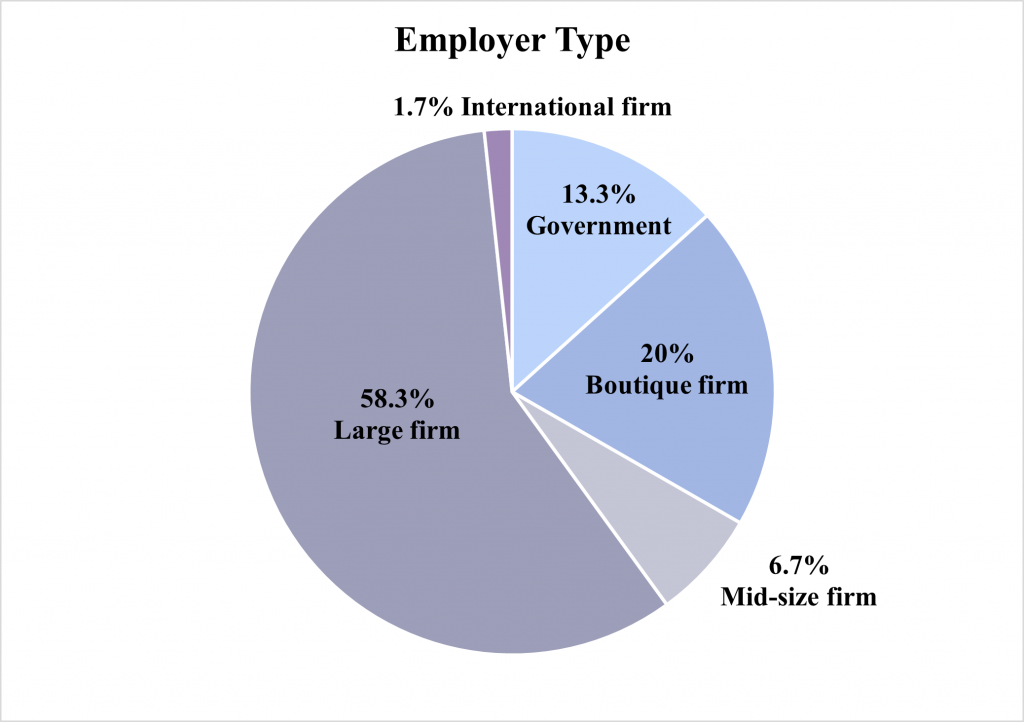
Of the 71 students who participated in the recruit, 27 (38.0%) expressed that their expected debt level had no influence on their recruitment decisions. While the responses from the students suggest that debt level was generally not a determinative factor, two students (2.8%) expressed that their debt load was the primary influence in making their employment decisions.
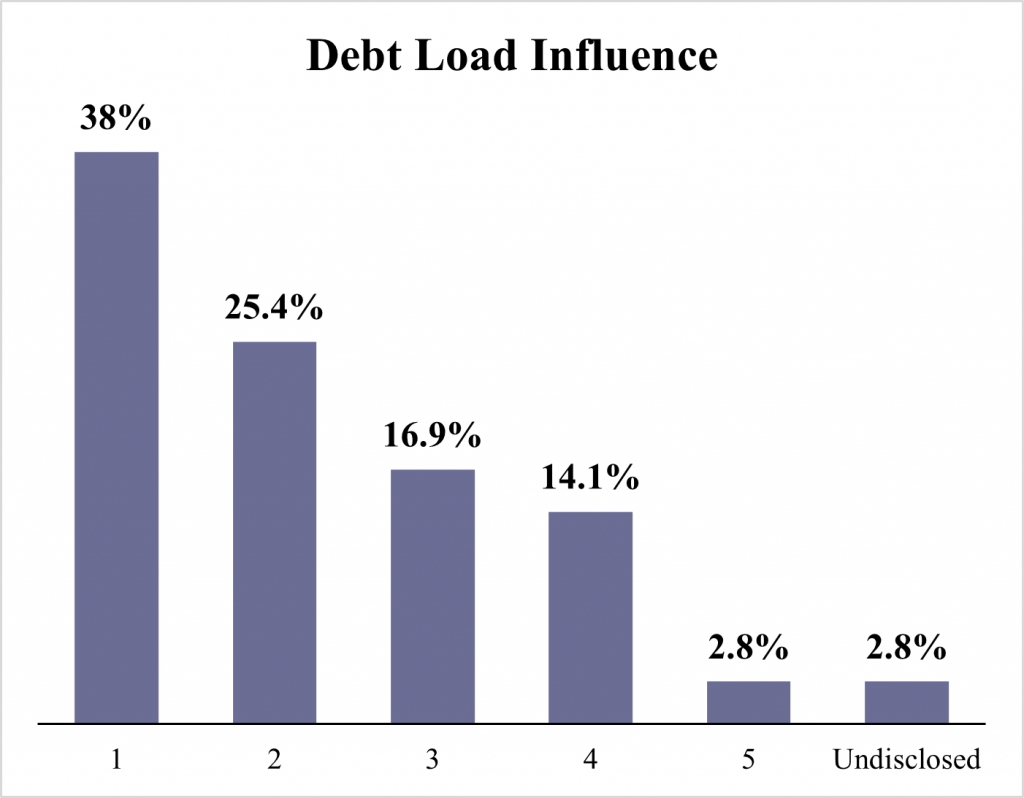
A majority of respondents found the Career Development Office (CDO) to have been very helpful (40 students; 50% of the respondents) or helpful (22 students; 27.5% of the respondents). However, there were two respondents who expressed that the CDO was not at all helpful (2.5% of the respondents).
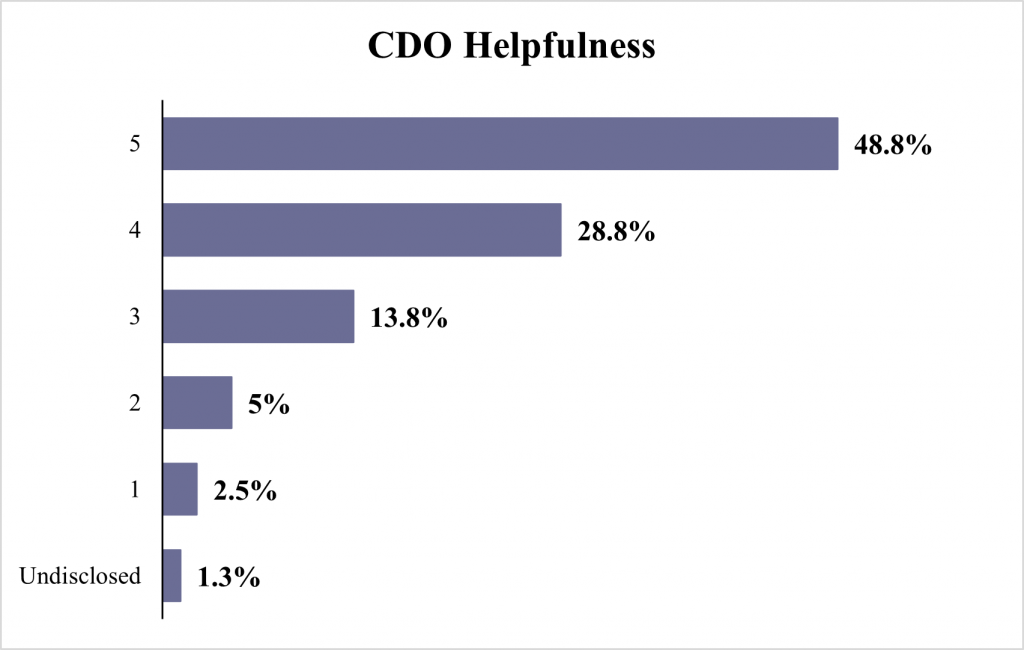
Most of the students (63 students; 88.7%) who participated in the recruit indicated that they did engage in some form of networking during the recruitment process. The most popular form of networking was the coffee chat.
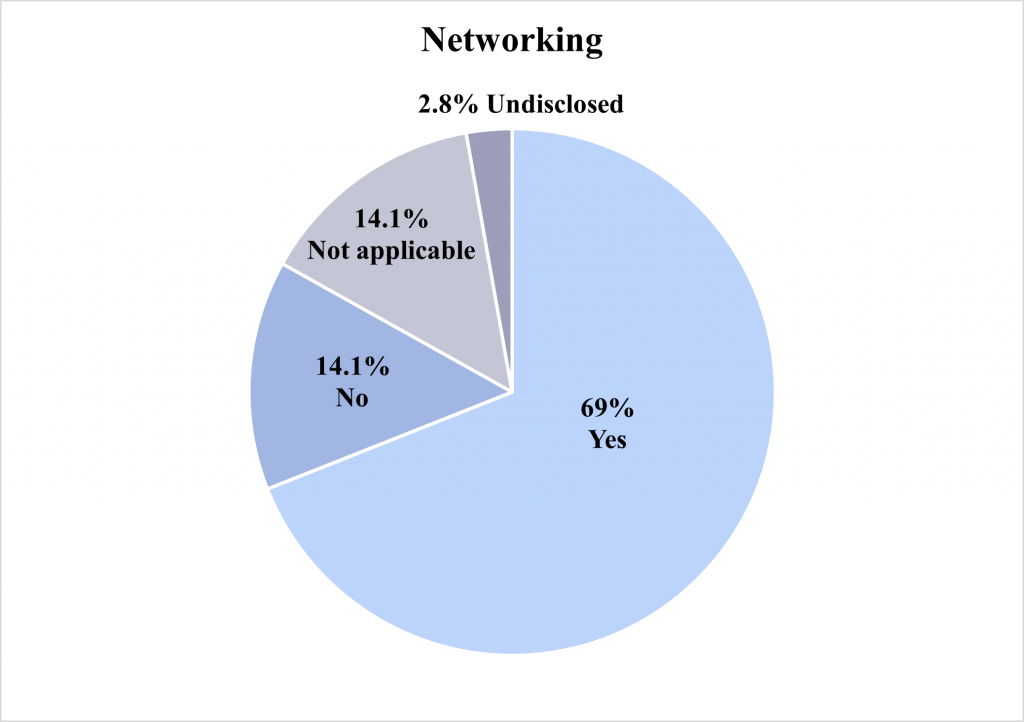
Correlations Between Grades, On-Campus Interviews (OCIs), In-Firm Interviews, and Offers Received
For this section, out of 71 respondents who participated in the recruit, only 58 students’ responses were used for analysis, as others did not report complete 1L grades. We expect that students who performed better academically or were satisfied with the outcome of the recruit to be more likely to participate in the survey. Because of this self-selection bias, students with HHs and Hs are likely to to be overrepresented at the expense of those reporting Ps. The expected grade percentage is based on the Faculty’s grade distribution guidelines to instructors.
| Grade | Expected | Reported | Representation |
| HH | 15% | 17.7% (72) | Overrepresentation |
| H | 30% | 41.9% (170) | Overrepresentation |
| P | 55% | 40.4% (164) | Underrepresentation |
| LP | 0% | 0% (0) | N/A |
| F | 0% | 0% (0) | N/A |
As with previous years, we assigned a numerical GPA to each letter grade (i.e., HH = 5, H = 4, P = 3, LP = 1, F = 0), and treated courses as equivalent in weight under the assumption that employers do not take into account each course’s weight.
From our survey, the median applicant in the Toronto Recruit had a GPA of 26. This median GPA is equivalent to 5 Hs and 2 Ps, or 1 HH, 3 Hs and 3 Ps, etc. The 25th percentile GPA was 25, the 75th percentile was 28, and distincting standing (the 90th percentile) was 30. These results are generally consistent with last year’s results, with the exception of the 25th percentile GPA being slightly higher this year.
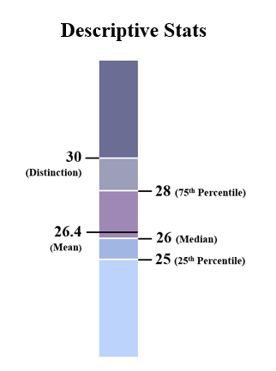
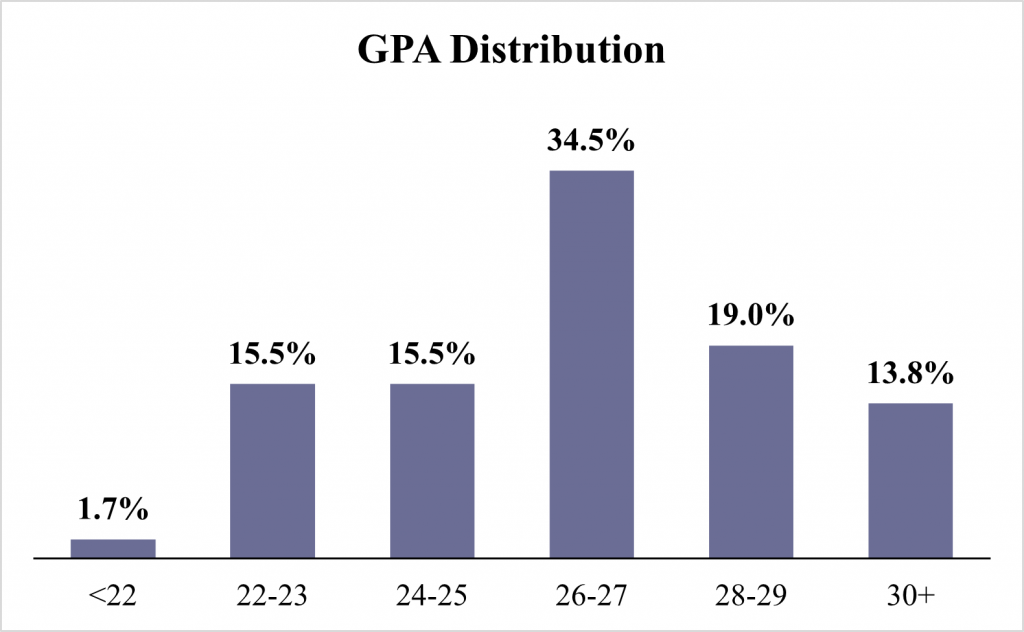
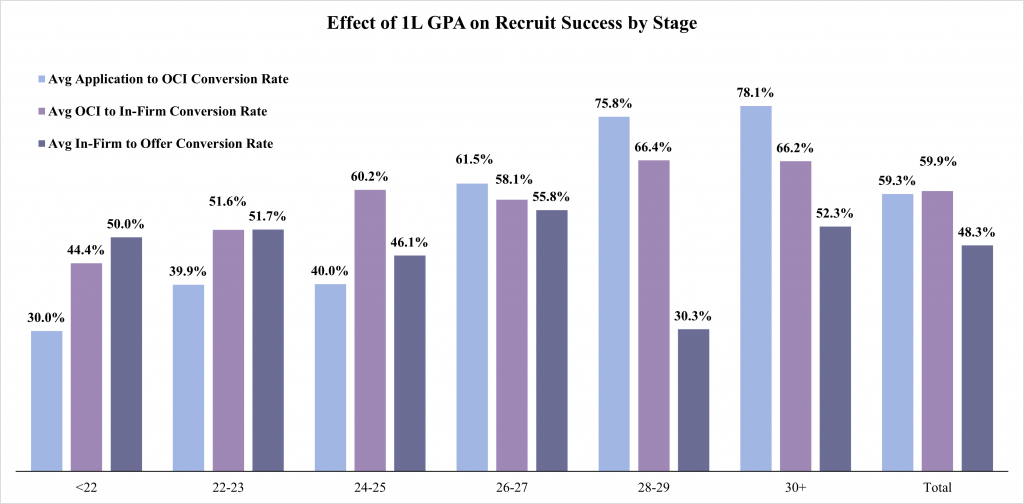
There was a general upward trend in the average number of OCIs received and the number of in-firm interviews received as GPA increased. The number of offers received, however, did not seem to correlate strongly with 1L GPA.
Using the Spearman rank correlation test, the relationship between GPA and application-to-OCI conversion rate was statistically significant with a moderate correlation. On the other hand, the weak correlation between GPA and OCI-to-in-firm conversion rate was not statistically significant. The same was the case for the relationship between GPA and in-firm-to-offer conversion rate.
When looking at factors that impact obtaining employment through the recruit (i.e., receiving at least one offer), logistic regression revealed that there exists a statistically significant association between the number of in-firm interviews received and employment, and between the number of in-firm interviews attended and employment. However, the associations between the number of OCIs received and employment and between GPA and employment were not statistically significant. Similar to last year, the data indicated that students who both received and attended more in-firm interviews were more likely to secure employment.
| In-Firm Interview Invitations Received | Total Number of Students | Number of Students Who Secured Employment | Employment (%) | 2023 Employment (%) | 2022 Employment (%) | 2021 Employment (%) |
| 1 | 9 | 8 | 88.9% | 50% | 50% | 38% |
| 2 | 4 | 3 | 75.0% | 25% | 50% | 45% |
| 3 | 6 | 4 | 66.7% | 100% | 79% | 69% |
| 4 | 7 | 7 | 100.0% | 71% | 75% | 88% |
| 5 | 3 | 2 | 66.7% | 100% | 82% | 90% |
| 6 | 3 | 3 | 100.0% | 100% | 100% | 100% |
| 7 | 4 | 4 | 100.0% | 100% | 100% | 100% |
| 8 | 4 | 4 | 100.0% | 100% | 100% | 100% |
| 9 | 5 | 4 | 80.0% | 100% | 100% | 100% |
| 10+ | 12 | 12 | 100.0% | 100% | 100% | 100% |
| In-Firm Interviews Attended | Total Number of Students | Number of Students Who Secured Employment | Employment (%) | 2023 Employment (%) | 2022 Employment (%) | 2021 Employment (%) |
| 1 | 10 | 9 | 90.0% | 50% | 50% | 40% |
| 2 | 7 | 6 | 85.7% | 25% | 60% | 55% |
| 3 | 4 | 3 | 75.0% | 100% | 80% | 67% |
| 4 | 10 | 10 | 100.0% | 82% | 90% | 93% |
| 5 | 19 | 17 | 89.5% | 100% | 95% | 95% |
| 6 | 3 | 3 | 100.0% | 100% | 100% | 100% |
| 7 | 3 | 3 | 100.0% | 100% | 100% | 100% |
| 8+ | 0 | 0 | N/A | 100% | 100% | N/A |
In conclusion, these results suggest that while students with higher GPAs tend to secure more OCIs, GPA alone is not a good indicator of whether a student is likely to secure an offer.
Effect of Gender and Race
For this section, out of 71 responses, three responses that did not provide necessary gender or race information were excluded. Compared to the U of T Law Class of 2025 profile statistics, there was an overrepresentation of females who completed the survey (67.6% vs. 56%). There was also a slight overrepresentation of racialized students who completed the survey (48.5% vs 41%).
Gender
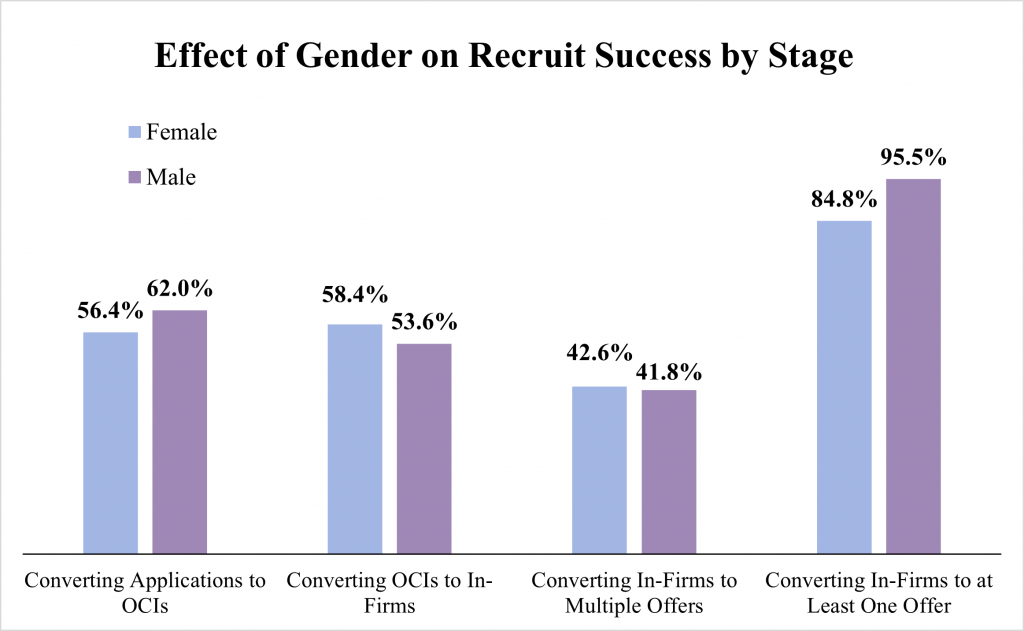
With regard to gender, males were slightly more successful than females at converting applications to OCIs, but for the remaining stages, females were slightly more successful. The difference at each stage, however, was not statistically significant under the Mann-Whitney U test. Based on the survey responses, applications from males were more likely to convert to OCI interviews (56.4% for females versus 62.0% for males). At the OCI stage, females were more successful at converting an OCI interview into an in-firm interview invitation (58.4% for females versus 53.6% for males). Females were also slightly more likely to convert in-firm interviews into offers (42.6% for females versus 41.8% for males). However, despite females being slightly more successful at most stages, a larger percentage of males secured employment compared to females (84.8% for females versus 95.5% for males). The difference in overall employment was also not statistically significant.
Race
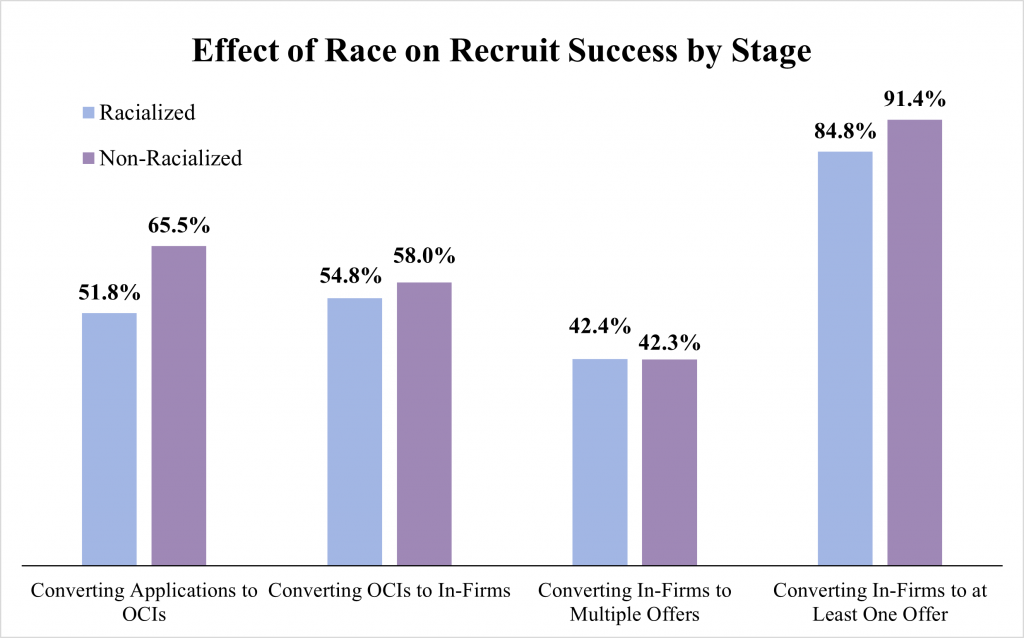
With regards to race, non-racialized students were more successful than racialized students at most stages of the recruit. The differences demonstrated between racialized and non-racialized students at each stage, however, was not statistically significant under Mann-Whitney U test. Based on the survey responses, applications from non-racialized students were more likely to be converted into OCIs than applications from racialized students (51.8% for racialized students versus 65.5% for non-racialized students). At the OCI stage, non-racialized students were slightly more successful than racialized students at converting OCIs into in-firm interview invitations (54.8% for racialized students versus 58.0% for non-racialized students). When it came to converting in-firm interviews into offers, there was almost no difference in performance between racialized and non-racialized students, but racialized students were more successful by a hair (42.4% for racialized students versus 42.3% for non-racialized students). In terms of overall employment, non-racialized students were more successful in securing a position out of the recruit, but this difference was not statistically significant (84.8% for racialized students versus 91.4% for non-racialized students). The overall trend in data suggested that while non-racialized students found more success at application and OCI stages, both racialized and non-racialized students performed equally well at the in-firm stage.
Race and Gender Combined
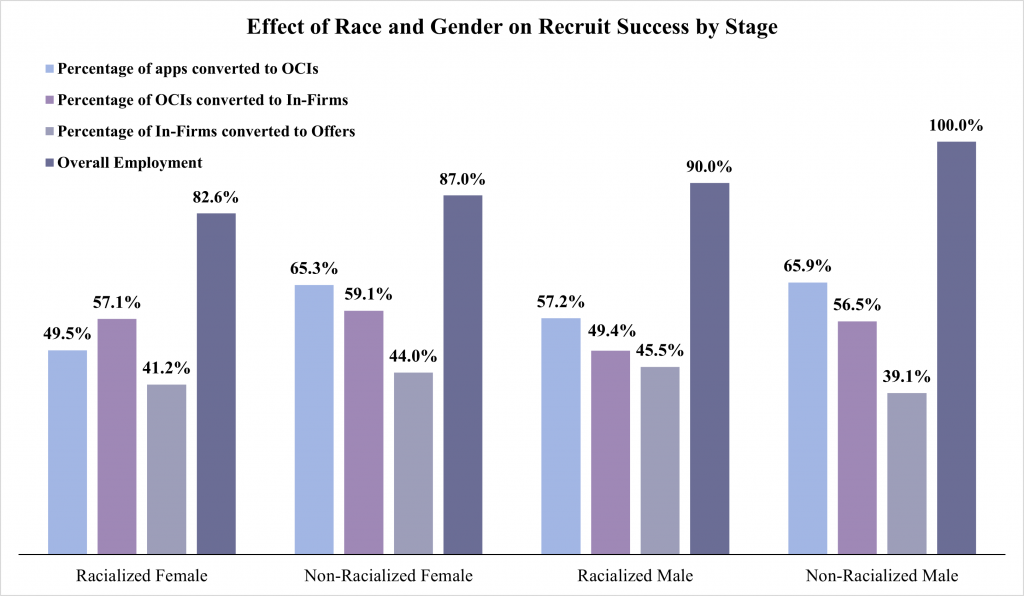
Finally, when looking at both race and gender combined, the differences between groups at each recruit stage were not statistically significant. Nonetheless, based on the survey data, non-racialized males were the most successful at converting applications to OCI invitations (65.9% of applications converted into OCI invitations). At the OCI stage, non-racialized females were the most successful at converting OCIs into in-firm interview invitations (59.1% of OCIs converted into in-firm invitations). During the in-firm stage, racialized males were the most successful (45.5% of in-firms converted into offers). When looking at overall employment, non-racialized males were the most successful, with 100% of the survey respondents who identified as a non-racialized male securing a position. Racialized females, while not that far behind other groups, had the least success at almost every stage of the recruit.





